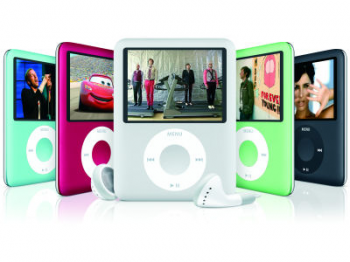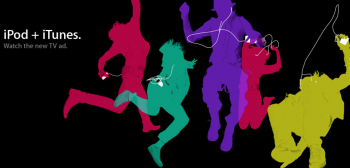Soap in the Chocolate Bar

Ipod Nano
Apple unveiled the latest variation on its iPod portable music player on September 7, and techies could hardly contain their gadget lust. David Pogue of the New York Times hailed the iPod Nano as “gorgeous, functional, and elegant . . .to see one is to want one” (Pogue, C1). Walter Mossberg of the Wall Street Journal, usually sober-minded in his evaluations of hardware and software, gasped that the player, the size of five credit cards stacked together, was “gorgeous and sleek . . . beautiful and incredibly thin . . . I am smitten” (Mossberg, B1). Apple has always excelled at promoting fashion; early in its history, Steve Jobs suggested that its computers be encased in exotic hardwoods.
Apple dominates the on-line music market, selling nearly three-quarters of all “legitimate” music downloads. The profit margins on its 99-cent downloads are razor-thin, however. Essentially, iTunes serves as a loss leader for the sale of iPods, which continue Apple’s tradition of pricing its proprietary formats at a premium in comparison with its competitors. Much of Apple’s appeal is grounded in its signification of status and conspicuous consumption.
Yet despite its sleekness, the iPod is a less than accommodating companion. All audio files must be converted to Apple’s proprietary AAC format, based on its FairPlay digital rights management system. Although FairPlay was hailed as less restrictive than other DRM schemes, tracks from rival download services such as Napster or MSN will not play on iPods. In addition to tethering Apple users to its proprietary formats, the rights of users can be altered at any time, at Apple’s sole discretion. FairPlay initially allowed downloads to be burned onto ten consecutive CDs; after that, their order must be rearranged. In May 2004, Apple reduced the number of CD copies from ten to seven, while raising the number of playback devices from three to five. The system also detects and blocks similar playlists, and does not allow songs to be edited, excerpted or sampled except exclusively on Apple’s terms. The iTunes music store does allow visitors to sample 30-second song clips, yet the clips are arbitrarily chosen and provide little insight, aside from the most repetitive selections. A former iTunes user sued Apple in 2005, accusing FairPlay of violating his fair use rights, and the iPod-iTunes DRM linkage as an “unlawful bundling and tying arrangement” that violates federal and California state laws by “suppressing competition, denying consumer choice, and forcing consumers to pay supra-competitive prices for their digital portable music players”(Cohen).

Ipod Itunes
Given the disadvantages in sound quality and fair use that surround existing forms of digital music, what are their advantages? First, the appeal of digital music is based in part on the ability to contain huge amounts of data in a small area — the “geek” thrill of massive storage. A second attraction is the possibility of immediacy, to sort and regroup files endlessly and summon a file quickly from the database. Third, customization via digital software is expedient, efficient, and accomplished at physical remove (although software nomenclature implies otherwise; we “grab” cuts and personalize collections via “drag and drop” applications). Greater possibilities for user programming result in music increasingly approached in terms of utility, rather than aesthetics (witness the popularity of ring tones, from which the recording industry derives revenue that surpasses downloads; never mind that the sound quality is akin to jamming a darning needle in one’s ear). Rather than songs themselves, play lists serve as a form of personal expression. In cyberspace, people collect lists rather than objects. ITunes features myriad play lists, although a cursory glance of celebrity play lists reveals their propensity for self-aggrandizement and self-promotion.
Through play lists and digital rights management, Apple and other companies attempt to construct a history for artifacts that have no history. Unless they are burned onto CDs, digital files have no physical manifestation. They consist of data, metadata, and a thumbnail, and therefore lack the “value” of a medium you can hold in your hands. When a product is delivered in a string of bits, rather than presenting itself in a physical form, it appears to have less value. Diminished or nonexistent physical presence undermines the notion of intellectual property; hence the widespread illicit copying of software and public support of file sharing. As goods lose their physicality, producers attempt to imbue them with greater and greater amounts of constructed value. This, ultimately, is Apple’s strategy: Sell sexy yet crippled hardware, make the content almost incidental, and let the users do the heavy lifting of promotion. For all of its style, the iPod is little more than an exercise in corporate bad faith. The chocolate bar is filled with soap.
Sources
Peter Cohen (2005). “iTunes User Sues Apple over FairPlay,” PCWorld.com, Jan. 7.
David Pogue (2005). “Defying Odds, One Sleek Ipod At a Time.” The New York Times, Sept. 15.
Walter Mossberg (2005). “Ipod’s Latest Siblings.” The Wall Street Journal, Sept. 8.
Image Credits:
1. Ipod Nano
2. Ipod Itunes
Please feel free to comment.
ipod nano
Tom’s article illuminates the relationship between technologies and marketing, real needs versus superfluous. In it, one senses that Ipod Nano is an ill-begotten gadget created by the Apple’s marketing department in order to satiate customers’ appetite for the new while cornering the Christmas market: a good warning for potential customers.
Soap in several chocolate bars
Excellent article, especially the description of the advantages of digital music. I also appreciate the author’s restraint in choosing not to name this essay “the digital turd in the punchbowl”.
I think Apple is not the only offender in producing digital hidden whammies. Yahoo Music touts a large warehouse of downloadable songs, but is less forthright the less marketable aspects of its subscription service, namely the required installation of the yahoo music engine and the same non-existent level of user help that it made famous with its free services.
Hardware vs. Software
I found this article interesting on a number of levels, including how these issues surrounding hardware vs. software and proprietary formats are so familiar to me from other media eras. In fact, I’m finding many of the same skirmishes going on in the early history of the phonograph. In those days, companies largely wanted to sell their phonographs, with the actual recordings functioning as the loss leader. Everything new is old again!
Digital music is interesting in the shift in commodity-as-object, from software back to hardware. While most music fans have fetishized their records and CDs as much or more than the playback technology, this changes with Apple’s iPod. The hardware, in this case, becomes the fetish object — since Tom rightly points out that “in cyberspace, people collect lists rather than objects.” So our commodity lust shifts to hardware — even down to the tell-tale white earbuds we listen through.
Since Tom’s posting just a few days ago, the iPod Nano has come under fire, just like its iPod predecessors. Articles in “Forbes” and elsewhere note that consumers have complained about the Nano’s screen cracking and chipping. Steve Jobs once again has been criticized for championing aesthetics over functionality. Apple is promising to replace broken iPod Nanos if something goes wrong. But I suspect our love affair, even with this news and Apple’s tightening reins around its download policies, will continue.
iPod Nano
Tom’s insights are all the more relevant with the recent release of Apple’s newest iPod, now featuring a 2.5 inch color video screen, capable of playing movies, music videos and television shows. Releasing a new version of the iPod so closely on the heels of the Nano seems at first like marketing suicide, until one examines Apple’s unique strategy of mediated planned-obscelences. Unlike car companies, or even PC computers, Apple continues to saturate the market with several versions of essentially the same technology, revamped and rewrapped in the enticing signature white “golden rectangle” design– from the iMac to the iBook to the iPod (the original iPod, I believe, spent some time on display at MOMA). The brilliance of the marketing tactic is that the various generations of machines do not cause previous models to go out of date. Instead, Apple makes technological devices with a surprisingly long consumer life BUT constantly introduces new machines on the market that offer more stylist benefits then actual technological advancement. Using this approach, Apple saturates the consumer market with Apple machines, making new models not really necessary to the consumer, but desirable to those that can afford them. No competition can really crack the market, because once you have an iPod, you don’t really need another machine–but you sure as hell WANT the NEWEST iPod, simply for a consumerist desire to have the newest version. It’s kind of like buying a new pair of jeans– the old one’s don’t get thrown out. They still serve the same function, but the new one’s have an ephemreal “newness” that makes them some way seem better. The analogy is appropriate, I hope, because the Apple campaign is really based in fashion, not technology. Thus most consumers are more aware that the Nano is “small and sleek” than the fact that it includes tougher download policies. And because of pricing, Nanos will continue to sell right alongside the newer versions of the iPod, until every consumer in America has white wires plugged into the sides of their heads.
how is chocolate go from producer to consumer in order dont give me no lies ether okay
thank you